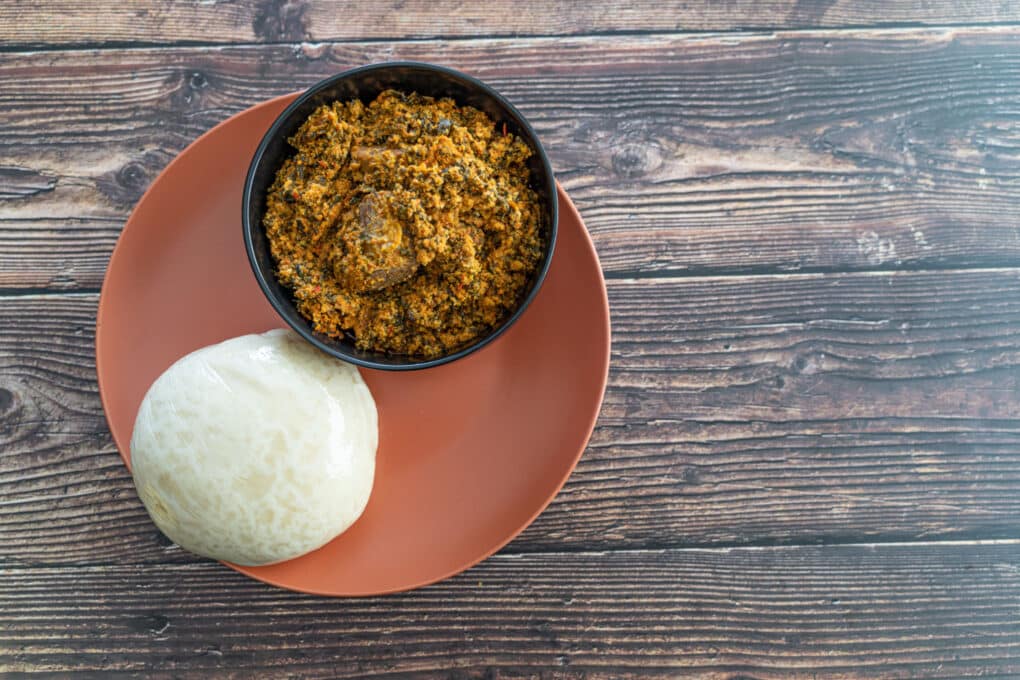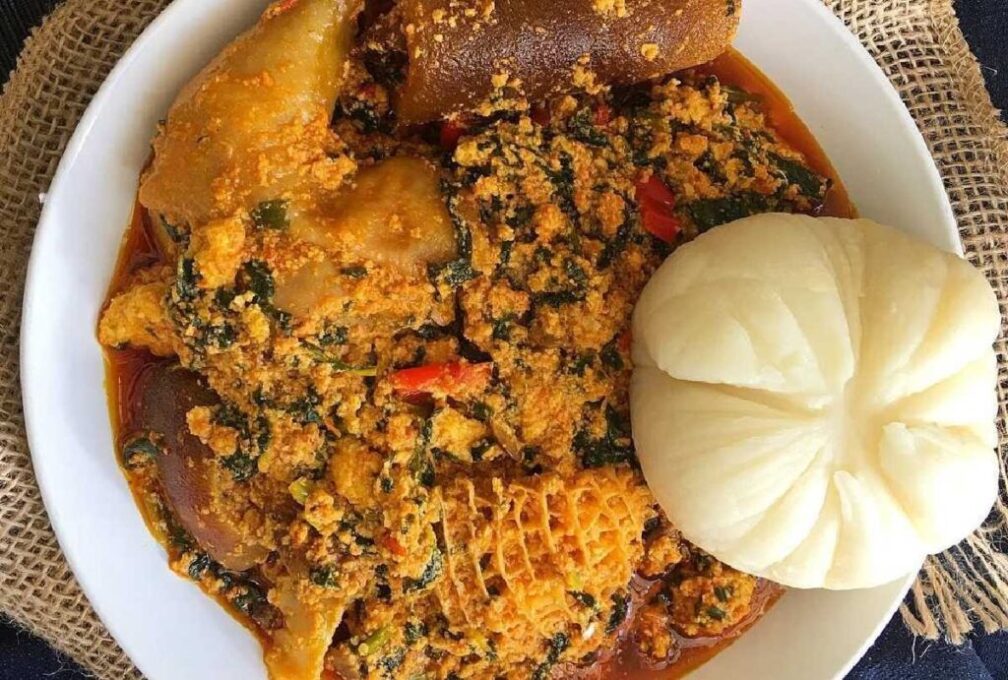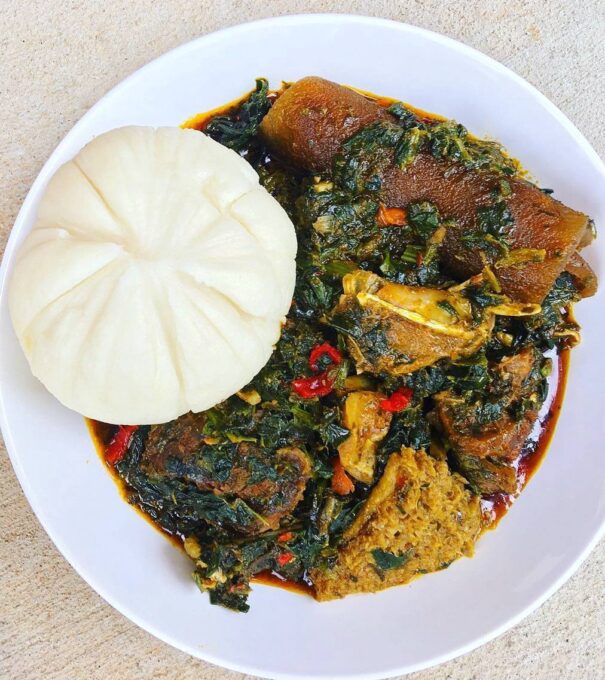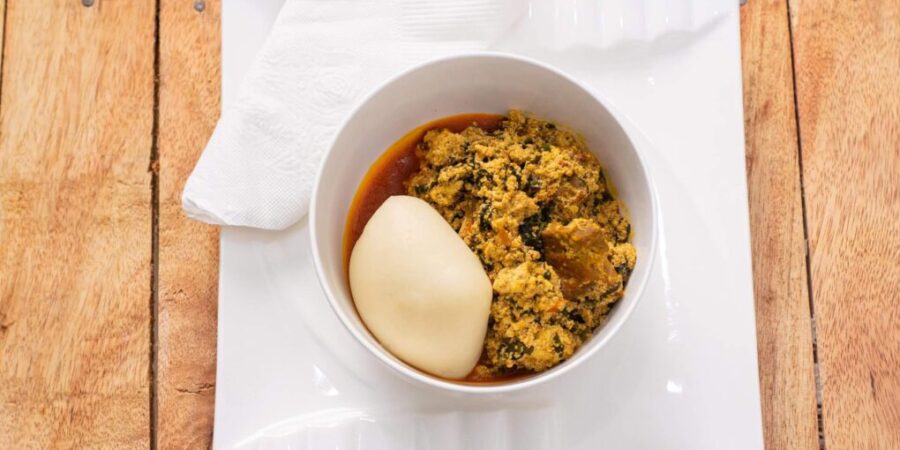How to make pounded yam is a question that is often asked by food enthusiasts who want to try their hand at preparing this classic West African dish. Pounded yam is a staple food in West African cuisine, and it is enjoyed with a variety of soups, stews, and sauces.
While making pounded yam can be time-consuming and requires some skill, the result is a delicious and nutritious dish that is worth the effort.
In this article, we will guide you through the steps for making pounded yam and offer some tips for serving it with other dishes.
Whether you are a seasoned cook or a beginner, we hope that this article will inspire you to try making pounded yam at home.

Cultural Significance of Pounded Yam
Pounded yam is a staple food in West African cuisine that is made by boiling yam and then pounding it until it becomes smooth and stretchy. It is often served with soups or stews and is considered a comfort food by many West Africans.
Pounded yam is a cultural staple in many West African countries, where it is often eaten for lunch or dinner. It is a symbol of hospitality and is often served to guests as a sign of respect and generosity.
Pounded yam is also an important part of many cultural and religious ceremonies, such as weddings and funerals, and is often served at festive occasions and celebrations.
Pounded yam is also seen as a symbol of tradition and is often associated with the older generation. Many people in West Africa grew up eating pounded yam as a staple food, a dish passed down from generation to generation. In this way, pounded yam is a reminder of cultural heritage and tradition.
In addition to its cultural significance, pounded yam is also a nutritious and filling food. It is a good source of carbohydrates and is often served with soups and stews that provide additional nutrients. This makes it a popular choice for people who need to fuel their bodies with energy for work or other activities.
YOU MAY ALSO LIKE:
- How to Cook Ogbono Soup
- <strong>How to cook Egusi soup in easy-to-follow recipes</strong>
- How to Make Afang Soup
Tips to pick the right yam
Look for fresh yams
Fresh yams are more likely to produce better quality pounded yam. Avoid yams that are old, discoloured, or have a lot of bruises, as these may affect the texture and taste of the pounded yam.
Choose the right variety
Different yam varieties have different textures and flavours. Some varieties are better for making pounded yam than others.
In general, yams that have a high starch content are better for making pounded yam, as they are more stretchy and elastic when pounded. Some popular yam varieties for making pounded yam include white, water, and yellow yam.
Ingredients to make pounded yam
Pounded yam is a popular West African dish that is made by pounding boiled yam until it becomes smooth and stretchy. Here is a simple recipe for making pounded yam:
Ingredients:
Yam (1-2 medium-sized tubers)
Water (enough to cover the yam)
Mortar and pestle (or food processor or stand mixer with a dough hook)
Preparing the Yam
Here are the instructions for peeling and cutting the yam into small cubes for making pounded yam:
Rinse the yam
Place the yam under running water and use a clean cloth or scrubber to remove any dirt or debris. Rinse the yam thoroughly until it’s clean.
Cut off the ends
Use a sharp knife to cut off both ends of the yam.
Peel the yam
Use a sharp knife to cut off the skin of the yam, starting from the top and cutting downwards in a circular motion.
Cut the yam into small cubes
Cut the peeled yam into small, evenly-sized cubes. This will help ensure that the yam cooks evenly and is easier to pound.
Rinse the yam cubes
Rinse the yam cubes in a bowl of cold water to remove any excess starch or residue.
Drain the yam cubes
Drain the water from the bowl and boil the yam cubes in a pot.
Now that your yam is peeled and cut into cubes, you can proceed with the next steps of boiling and pounding the yam to make pounded yam.
Boiling the Yam
Here are the steps for boiling the yam until it’s soft and tender:
Place the cubed yam in a large pot
Transfer the cubed yam into a large pot and add enough water to cover the yam.
Boil the yam on medium-high heat
Place the pot on the stove and bring the water to a boil. Reduce the heat to medium-high and allow the yam to boil for 20-30 minutes or until it’s soft and tender.
Check for doneness
To check if the yam is done, insert a fork or knife into a yam cube. If it goes in easily and the yam feels soft, it’s done. If the yam is still firm, continue boiling it for a few more minutes.
Drain the water
Once the yam is done, turn off the heat and carefully pour out the hot water into a sink or drain. Use a colander or strainer to hold the yam cubes in the pot while you drain the water.
Allow the yam to cool
Let the yam cool down for a few minutes before proceeding to the next step.
Now that your yam is boiled and tender, you can proceed with the next step of pounding the yam to make pounded yam

How to pound Yam
When you are about to pound your yam you can either use a mortar and pestle, food processor or stand mixer
Here are the instructions on how to pound the yam using a mortar and pestle, food processor, or stand mixer:
Using a mortar and pestle:
Place a few cubes of boiled yam in the mortar.
Use the pestle to pound the yam, pressing and twisting it against the side of the mortar. Continue pounding until the yam is smooth and stretchy.
Add more yam cubes to the mortar and continue pounding until all the yam cubes are mashed and smooth.
Repeat the pounding process until all the yam is mashed into a smooth, stretchy consistency.
Using a food processor:
Place the boiled yam cubes in a food processor.
Pulse the food processor until the yam is mashed into a smooth consistency. Stop the food processor and scrape down the sides of the bowl with a spatula as needed.
Continue processing the yam until it’s smooth and stretchy. Be careful not to over-process the yam, as this can make it too sticky or gluey.
Using a stand mixer:
Place the boiled yam cubes in the bowl of a stand mixer.
Use the paddle attachment to mix the yam on medium speed until it’s mashed into a smooth consistency.
Continue mixing the yam until it’s stretchy and smooth. Be careful not to over-mix the yam, as this can make it too sticky or gluey.
Note: When pounding yam, it’s important to add water gradually to the yam to make it softer and stretchier. This can be done by gradually adding small amounts of hot water to the yam while pounding until the desired consistency is reached.
SEE ALSO:
Pounded yam soups suggestions
Pounded yam is a versatile dish that can be served with a wide variety of soups, stews, and sauces. Here are some popular soup and stew pairings for pounded yam:
Egusi soup
Egusi soup is a popular soup in West Africa made with ground melon seeds, vegetables, and meats. It is often served with pounded yam.
Efo riro
Efo riro is a Nigerian stew made with spinach or other leafy greens and a variety of meats. It is often served with pounded yam or other fufu dishes.
Oxtail stew
Oxtail stew is a hearty stew made with oxtail, vegetables, and a variety of spices. It is often served with pounded yam or other fufu dishes.
Okra soup
Okra soup is a popular West African soup made with okra, meat, and various other vegetables and spices. It is often served with pounded yam.
Oha soup
Oha soup is a traditional Nigerian soup that is made from a variety of vegetables, including oha leaves and uziza leaves. It is often served with goat meat or chicken and is a popular dish in the eastern region of Nigeria.
Bitter leaf soup
Bitter leaf soup is a Nigerian soup made with bitter leaf, meat, and various spices. It is often served with pounded yam or other fufu dishes.
Vegetable soup
Vegetable soup is made from a variety of vegetables, including spinach, pumpkin leaves, and other greens. It is often served with a protein such as chicken or fish and is a great option for vegetarians or those looking for a healthier meal.
Pepper soup
Pepper soup is a spicy soup made from various meats, including chicken, fish, or goat. It is seasoned with a variety of spices and is often served with pounded yam or fufu.
Stew
Stews made with chicken, beef, or fish are a popular accompaniment to pounded yam. They are often thick and flavorful and are perfect for dipping the pounded yam into.
To serve pounded yam, is often rolled into small balls and served alongside the soup or stew. Diners can then use the balls of pounded yam to scoop up the soup or stew and enjoy the flavours together.
No matter which soup, stew, or sauce you choose to serve with your pounded yam, it’s sure to be a delicious and satisfying meal that all will enjoy!

How to serve pounded yam
When it comes to serving pounded yam with other dishes, there are a few things to keep in mind to ensure that you create a delicious and satisfying meal. Here are some suggestions on how to properly serve pounded yam with other dishes:
Serve hot
Pounded yam should be served hot, as it can get gummy and unappetizing when it cools down. Make sure to reheat the yam before serving it with your soup, stew, or sauce.
Serve in small portions
Pounded yam is a heavy and filling food, so serving it in small portions is best. Aim for about a handful-sized portion per person, and serve additional portions as needed.
Use a soup plate
When serving pounded yam with soup, it’s best to use a soup plate or deep dish to contain the soup and yam. This will prevent the soup from spilling over onto the table and make it easier to eat.
Add extra liquid
If your soup, stew, or sauce is too thick to eat with pounded yam easily, you can add extra liquid to thin it out. This will make dipping the yam into the soup easier and create a more enjoyable eating experience.
Pounded Yam nutritional Value
Pounded yam is a staple food in many West African countries and is made from boiled yam that is pounded until it becomes a stretchy dough-like consistency.
Pounded yam is a good source of carbohydrates, fibre, vitamins, and minerals.
Here are some nutritional values of pounded yam per 100-gram serving:
Calories: 118
Carbohydrates: 28 grams
Fibre: 4 grams
Protein: 1.5 grams
Fat: 0.2 grams
Vitamin C: 17% of the daily recommended intake (DRI)
Vitamin B6: 16% of the DRI
Potassium: 10% of the DRI
Magnesium: 6% of the DRI
While pounded yam is a good source of carbohydrates and fibre, it is important to note that it is also high in calories and should be consumed in moderation.
It is often paired with soups and stews rich in vegetables and protein, which help balance the meal’s nutritional value.
Conclusion
In conclusion, pounded yam is a delicious and nutritious food that plays a significant role in African cuisine and culture. It is a dish that has been passed down from generation to generation and is often eaten communally, emphasizing the importance of sharing food and coming together as a community.
Making pounded yam requires patience and skill, but the result is a smooth and stretchy texture perfect for different soups, stews, and sauces.
Many different types of soups and stews can be served with pounded yam, each with its unique flavour and ingredients.
Whether you are a fan of West African cuisine or just looking for a hearty and satisfying meal, pounded yam is definitely worth trying.
Its cultural and social significance, delicious taste, and nutritional benefits make it a dish loved and appreciated by many.

